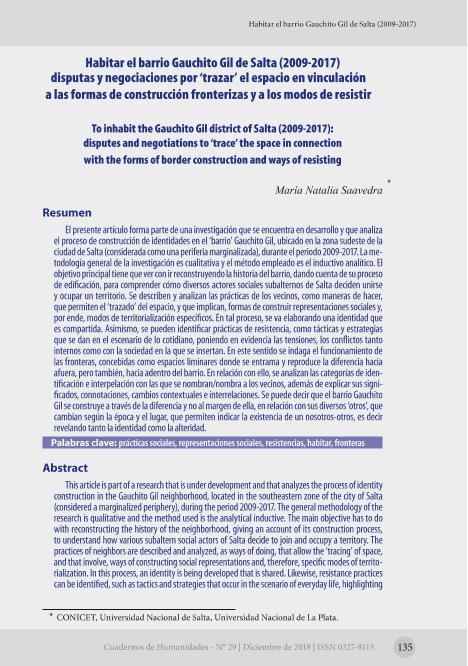Mostrar el registro sencillo del ítem
dc.contributor.author
Saavedra, Maria Natalia

dc.date.available
2019-09-23T18:07:08Z
dc.date.issued
2018-07
dc.identifier.citation
Saavedra, Maria Natalia; Habitar el barrio Gauchito Gil de Salta (2009-2017) : disputas y negociaciones por trazar el espacio en vinculación a las formas de construcción fronterizas y a los modos de resistir; Universidad Nacional de Salta. Facultad de Humanidades; Cuadernos de Humanidades; 29; 7-2018; 135-154
dc.identifier.issn
0327-8115
dc.identifier.uri
http://hdl.handle.net/11336/84162
dc.description.abstract
El presente artículo forma parte de una investigación que se encuentra en desarrollo y que analiza el proceso de construcción de identidades en el ‘barrio’ Gauchito Gil, ubicado en la zona sudeste de la ciudad de Salta (considerada como una periferia marginalizada), durante el periodo 2009-2017. La metodología general de la investigación es cualitativa y el método empleado es el inductivo analítico. El objetivo principal tiene que ver con ir reconstruyendo la historia del barrio, dando cuenta de su proceso de edificación, para comprender cómo diversos actores sociales subalternos de Salta deciden unirse y ocupar un territorio. Se describen y analizan las prácticas de los vecinos, como maneras de hacer, que permiten el ‘trazado’ del espacio, y que implican, formas de construir representaciones sociales y, por ende, modos de territorialización específicos. En tal proceso, se va elaborando una identidad que es compartida. Asimismo, se pueden identificar prácticas de resistencia, como tácticas y estrategias que se dan en el escenario de lo cotidiano, poniendo en evidencia las tensiones, los conflictos tanto internos como con la sociedad en la que se insertan. En este sentido se indaga el funcionamiento de las fronteras, concebidas como espacios liminares donde se entrama y reproduce la diferencia hacia afuera, pero también, hacia adentro del barrio. En relación con ello, se analizan las categorías de identificación e interpelación con las que se nombran/nombra a los vecinos, además de explicar sus significados, connotaciones, cambios contextuales e interrelaciones. Se puede decir que el barrio Gauchito Gil se construye a través de la diferencia y no al margen de ella, en relación con sus diversos ‘otros’, que cambian según la época y el lugar, que permiten indicar la existencia de un nosotros-otros, es decir revelando tanto la identidad como la alteridad.
dc.description.abstract
This article is part of a research that is under development and that analyzes the process of identity construction in the Gauchito Gil neighborhood, located in the southeastern zone of the city of Salta (considered a marginalized periphery), during the period 2009-2017. The general methodology of the research is qualitative and the method used is the analytical inductive. The main objective has to do with reconstructing the history of the neighborhood, giving an account of its construction process, to understand how various subaltern social actors of Salta decide to join and occupy a territory. The practices of neighbors are described and analyzed, as ways of doing, that allow the ‘tracing’ of space, and that involve, ways of constructing social representations and, therefore, specific modes of territo- rialization. In this process, an identity is being developed that is shared. Likewise, resistance practices can be identified, such as tactics and strategies that occur in the scenario of everyday life, highlighting tensions, conflicts both internally and with the society in which they are inserted. In this sense, the operation of the borders is explored, conceived as liminal spaces where the difference is reproduced and reproduced outside, but also towards the inside of the neighborhood. In this regard, the cate- gories of identification and interpellation with which neighbors are named / named are analyzed, in addition to explaining their meanings, connotations, contextual changes and interrelationships. It can be said that the Gauchito Gil neighborhood is built through difference and not on the margin of it, in relation to its various ‘others’, which change according to the time and place, which indicate the existence of a we-others, that is, revealing both identity and otherness.
dc.format
application/pdf
dc.language.iso
spa
dc.publisher
Universidad Nacional de Salta. Facultad de Humanidades
dc.rights
info:eu-repo/semantics/openAccess
dc.rights.uri
https://creativecommons.org/licenses/by-nc-sa/2.5/ar/
dc.subject
Practicas Sociales
dc.subject
Representaciones Sociales
dc.subject
Resistencias
dc.subject
Fronteras
dc.subject.classification
Comunicación de Medios y Socio-cultural

dc.subject.classification
Comunicación y Medios

dc.subject.classification
CIENCIAS SOCIALES

dc.title
Habitar el barrio Gauchito Gil de Salta (2009-2017) : disputas y negociaciones por trazar el espacio en vinculación a las formas de construcción fronterizas y a los modos de resistir
dc.title
To inhabit the Gauchito Gil district of Salta (2009-2017): disputes and negotiations to ‘trace’ the space in connection with the forms of border construction and ways of resisting
dc.type
info:eu-repo/semantics/article
dc.type
info:ar-repo/semantics/artículo
dc.type
info:eu-repo/semantics/publishedVersion
dc.date.updated
2019-08-08T18:07:23Z
dc.journal.volume
29
dc.journal.pagination
135-154
dc.journal.pais
Argentina

dc.journal.ciudad
Salta
dc.description.fil
Fil: Saavedra, Maria Natalia. Consejo Nacional de Investigaciones Científicas y Técnicas. Centro Científico Tecnológico Conicet - Salta. Instituto de Investigaciones en Ciencias Sociales y Humanidades. Universidad Nacional de Salta. Facultad de Humanidades. Instituto de Investigaciones en Ciencias Sociales y Humanidades; Argentina
dc.journal.title
Cuadernos de Humanidades
dc.relation.alternativeid
info:eu-repo/semantics/altIdentifier/url/http://humani.unsa.edu.ar/cdh/index.php/CDH/article/view/13
Archivos asociados
